'

|
All About Gardening and Gardening Q & A by Pernell Gerver |
|
Bookmark
this page or add it to your favorites now! |
|
"Heirloom Apple Tasting & Growing Your Own Antique Apples" |
|
Apples have a very long history, having been in cultivation since ancient times. They originated in what is now Kazakhstan and the first-known varieties were introduced in the 1400's. It wasn't until the 1500's that they began to be used for food. Up until then their main use had been for cider and when they were first used for food, they were seldom eaten fresh. They were usually dehydrated then reconstituted for use in pies which back then were eaten as breakfast foods, not the dessert we know them to be today. Over the centuries, there have been thousands and thousands of different apple varieties that have been used for cooking and eating fresh. Here in America, there were over 18,000 varieties by the end of the 1700's. Many of those old-time varieties have, unfortunately, disappeared from the market. Less familiar now, but popular at one time are the antique apples, really old varieties, with interesting and unusual names like 'Cox Orange Pippin,' 'Roxbury Russett,' and 'Golden Russett.' These antique apple varieties are not only rich in history, but also rich in flavor.
Most antique apples have folklore history. The story behind the 'Cox Orange Pippin' is Cox was the name of the woman who discovered it. In 1830, she owned a 'Ripsten Pippin' tree, saw a bee pollinating a blossom, tied a ribbon around it, and planted the seeds of the apple that came from that spot and the story is this is the apple that came from that seed. |
|
|

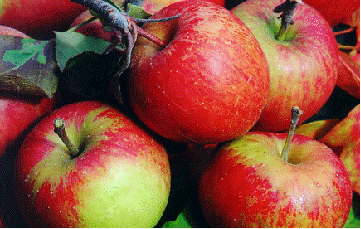 An
old variety named 'Cox Orange Pippin' is very hard, very spicy, but
also sweet. It's the second most popular apple in the world, next to
'Gala.' It's a good all-around, multi-use apple. It makes great pies.
As an eating apple it's hard, crisp, juicy, slightly spicy, but also
sweet. The fruit does not turn red, instead it's somewhat orangey and
it's one of my favorite apples.
An
old variety named 'Cox Orange Pippin' is very hard, very spicy, but
also sweet. It's the second most popular apple in the world, next to
'Gala.' It's a good all-around, multi-use apple. It makes great pies.
As an eating apple it's hard, crisp, juicy, slightly spicy, but also
sweet. The fruit does not turn red, instead it's somewhat orangey and
it's one of my favorite apples.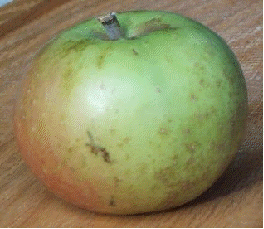 Another
historical apple, 'Roxbury Russet,' has its origins in Roxbury,
Massachusetts before the Revolutionary War - back in the late 1600's,
to early 1700's. They were originally in England and where the stock
was brought over seedlings were found. It's not a particularly pretty
apple (they used to be called leather coats) since it has a brownish
russetting covering a green skin, but it's a highly sugared apple
with twenty percent more fruit sugar than most apples. It's a great
cooking apple - for sauce, pies, and cider making.
Another
historical apple, 'Roxbury Russet,' has its origins in Roxbury,
Massachusetts before the Revolutionary War - back in the late 1600's,
to early 1700's. They were originally in England and where the stock
was brought over seedlings were found. It's not a particularly pretty
apple (they used to be called leather coats) since it has a brownish
russetting covering a green skin, but it's a highly sugared apple
with twenty percent more fruit sugar than most apples. It's a great
cooking apple - for sauce, pies, and cider making.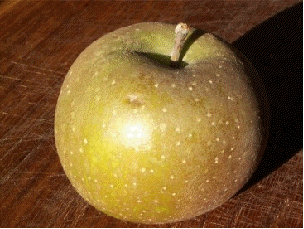 'Golden
Russet,' an antique apple variety that also dates back to
pre-Revolutionary War time, resembles 'Roxbury Russet.' 'Golden
Russet' is very round and much more russetted. Its origin is Concord,
Massachusetts where it was developed in 1750. The flavor of 'Golden
Russett' is dense, very juicy, and very sweet. A bushel of 'Golden
Russett' weighs approximately five to six pounds more than a bushel
of 'Cortland' because they are very dense and very juicy. It has a
great taste.
'Golden
Russet,' an antique apple variety that also dates back to
pre-Revolutionary War time, resembles 'Roxbury Russet.' 'Golden
Russet' is very round and much more russetted. Its origin is Concord,
Massachusetts where it was developed in 1750. The flavor of 'Golden
Russett' is dense, very juicy, and very sweet. A bushel of 'Golden
Russett' weighs approximately five to six pounds more than a bushel
of 'Cortland' because they are very dense and very juicy. It has a
great taste.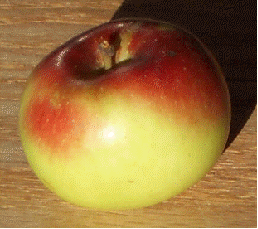 'Lady'
is the oldest apple variety still being grown today. Its history
dates back to the Roman Empire. It's a small, rounded apple that has
a sweet flavor. Because of its small size, it was popular with women
during the Renaissance. It's said they would keep one tucked in their
bosom and use it to freshen their breath. It's also known as the
Christmas apple because it was widely used as a decoration on wreaths
hung for Christmas.
'Lady'
is the oldest apple variety still being grown today. Its history
dates back to the Roman Empire. It's a small, rounded apple that has
a sweet flavor. Because of its small size, it was popular with women
during the Renaissance. It's said they would keep one tucked in their
bosom and use it to freshen their breath. It's also known as the
Christmas apple because it was widely used as a decoration on wreaths
hung for Christmas.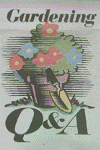 by
Pernell Gerver
by
Pernell Gerver